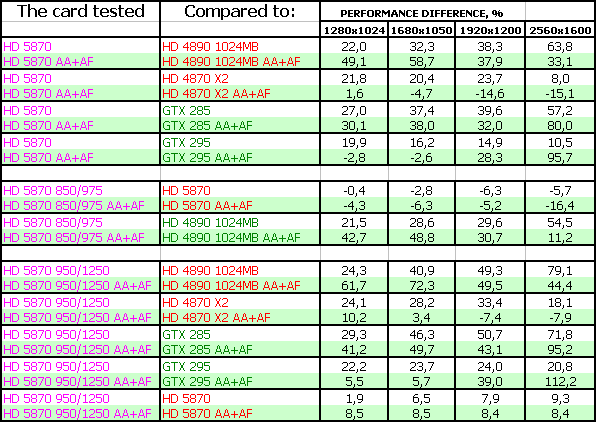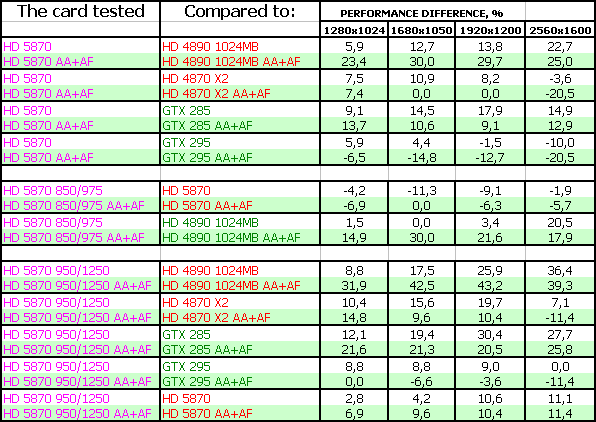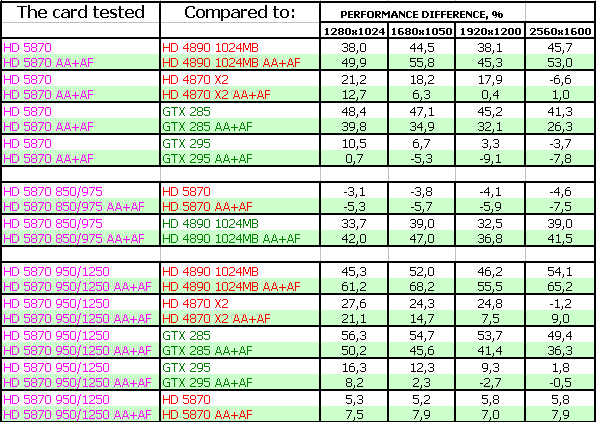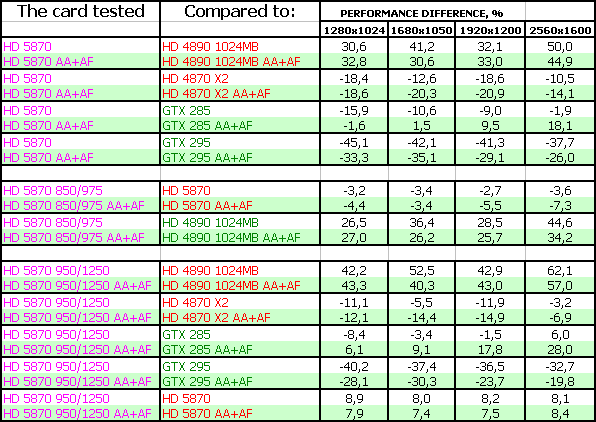 |
||
|
||
| ||
Performance in gamesTestbed:
Benchmarks:
Note that performance diagrams are located on dedicated pages. S.T.A.L.K.E.R. Clear SkyPerformance charts: S.T.A.L.K.E.R.  World In ConflictPerformance charts: World In Conflict  CRYSIS, Rescue, DX10, Very HighPerformance charts: CRYSIS, Rescue, DX10, Very High  CRYSIS Warhead, Cargo, DX10, Very HighPerformance charts: CRYSIS Warhead, Cargo, DX10, Very High  Far Cry 2 Company Of Heroes 3DMark Vantage, Graphics MARKSPerformance charts: 3DMark Vantage, Graphics MARKS  Devil May Cry 4, SCENE1Performance charts: Devil May Cry 4, SCENE1  Lost Planet EC Colonies, SCENE1Performance charts: Lost Planet EC Colonies, SCENE1  ConclusionsATI RADEON HD 5870 1024MB is a superb graphics card in its price range (its recommended price for the end of September, 2009, was 399 USD). This product easily outperforms its competitor form the same price range (GeForce GTX 285) and sometimes even catches up with the more expensive GeForce GTX 295. And the unprecedented overclocking allows this new single-GPU card to compete with the dual-GPU GTX 295. The new model performs well in games and in synthetic tests. The HD 5870 shows strong results in synthetic tests even in comparison with the dual-GPU cards from previous generations, often being faster! It's noticeably faster than single-GPU cards and the old HD 4800 in all cases. Cypress is evidently a successful product, the most powerful among existent solution. What concerns test results obtained in Company of Heroes, the twofold difference appears there, because the ATI driver wouldn't disable VSync in this game in Windows Vista, even though this option is disabled. So performance of all ATI cards in this game is limited to 60-Hz refresh rate, so it's impossible to get more than 60 fps. We hope that programmers will fix this bug. Besides, we may remove this test from our procedure soon. The most illustrative tests are Crysis (both versions) and FarCry2. They show the true worth of the new ATI (AMD) product. Besides, tests of the HD 5870 operating at the reduced HD 4890 frequency (in order to compare both products at the same frequencies) reveal no bottlenecks in memory bandwidth. Moreover, the 48xx had very high memory bandwidth for the cores, and its insignificant increase in the 58xx only balances GPU and local video memory. As we can see, the core has grown by almost two times, while memory bandwidth has grown only by 25%. However, we don't see twofold performance gains versus the 4890. Perhaps, performance is limited by something in high resolutions. Probably by memory bandwidth. The HD 5870 has got several new functions and improvements. First of all, it's sterling support for DirectX 11 (it's the very first graphics card that has this technology). For two, it's improved quality of anisotropic filtering, angle of view has no effect anymore (we'll cover this topic in one of the next articles about the HD 58xx). Besides, all advantages of the fast AA available in the 4xxx series have been preserved. Another important feature for gamers is support for three monitors. That is, it's not just an extended desktop or movies. Games are supported as well. The driver currently supports over 30 titles, which can be displayed in a single wide field on three monitors. That is a gamer can buy three identical monitors, install them next to each other and get a stunning effect when you plunge into the game world. We should compare this effect to the famous stereo effect from NVIDIA (GeForce 3D-Vision) and see which technology feels better (yours truly have already seen the stereo image of 3D-Vision, and it was very impressive, now we should play with three monitors -- we hope that we'll soon publish an article about these two technologies). There are no sterling games for DirectX 11 yet, of course. So we can compare games only in DirectX 10. So our today's tests are only preliminary. We'll get back to this topic, as more DX11 games appear. DX11 comparisons will be honest only after NVIDIA launches its own card supporting this version. As for now, ATI RADEON HD 5870 is the one and only king of 3D graphics among single-GPU solutions. However, considering low production volume of the GTX 295, which is not much faster at that, we can say that the 5870 X2 gets its crown even before it's born. The 5870 X2 will have no competitors whatsoever, unless NVIDIA roll out worthy solutions by that time. Now about several drawbacks: first of all, this card is very long due to its cooling system (it could have been possible to come up with a different design not to exceed the PCB length). It applies series restrictions on PC enclosure dimensions. The second problem, actually a peculiarity, is peak power consumption of 190W. Such graphics cards will be bought by owners of powerful PSUs, so it's not a problem. And here goes a huge advantage -- power consumption drops to 27W (!) in 2D mode with no heavy load owing to power saving technologies integrated into the core. This card is very good anyway, and it produces only positive impressions. This new product from AMD starts a new DirectX 11 competition. Besides, it performs very well with DX10, too. We are looking forward to NVIDIA's response. We express our gratitude to AMD for the provided graphics card.
The PSU has been provided by TAGAN, the monitor has been provided by NVIDIA. Write a comment below. No registration needed!
|
Platform · Video · Multimedia · Mobile · Other || About us & Privacy policy · Twitter · Facebook Copyright © Byrds Research & Publishing, Ltd., 1997–2011. All rights reserved. |